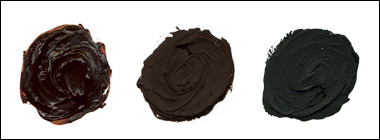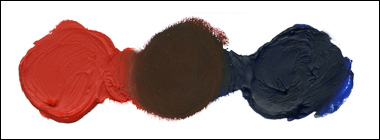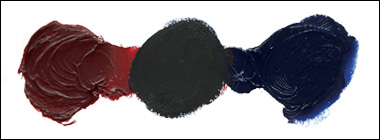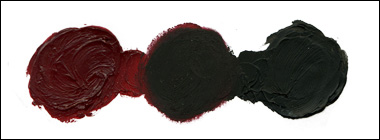If you’re an oil painter then you know that mixing neutral colors like brown or black can be just as tricky as any other color. And although it might seem easy enough to just use them straight from the tube, those basic blacks and browns are probably TOO neutral for the colors that you’re trying to paint.
As I explained in my first article on mixing color, as long as you have red, blue, and yellow paint, then there’s nothing stopping you from mixing any color you want. By mixing your own “neutral colors” you can put as much or as little intensity into them as you’d like.
In the picture below, you’ll see three very neutral colors. They are (from left to right) Burnt Sienna, Burnt Umber, and Ivory Black.
Although I do have each of these colors, I try not to use them too much. Part of that is because I prefer to create paintings with more vibrant color than dark, dull color. And when I do need a brown or dark black, I usually mix my own.
Some artists, if put in a similar situation, might try to get a brown color by taking Cadmium Yellow and mixing it with Ivory Black. Since Cadmium Yellow is kind of an orange color, adding black to darken it up into a brown seems to make sense.
However, as you can see, it doesn’t quite work like that. Ivory Black acts a lot like a very dark Ultramarine Blue, so it mixes with Cadmium Yellow to create a deep green.
A lot of other artists would take their Cadmium Red and just add black. As you can see, this solution actually does create a respectable brown.
But it’s probably not the best brown, and to me it looks a bit dull. Since I’m not satisfied with it, let’s visit the color wheel and see if there’s a better way.
What colors make brown?

However, I’ve mentioned before that I almost never use green paint from a tube, and you might be the same way.
So, instead of mixing blue and yellow to make green and then mixing that green with Cadmium Red; there’s actually a way to get brown by only mixing two colors.
(Here’s the point where reading my first color mixing article would come in handy.)
Since every color actually has an “additional color” in it, all we have to do is find the TWO colors that contain the THREE colors between them that are necessary to make brown.
In other words, if I mix a red that has some yellow in it (like Cadmium Red) with a blue that has some yellow in it (Like Pthalo Blue) then I should have all the components I need to make brown: Red, Blue, and Yellow.
So I did, and I was able to get a much more vibrant red/brown than with the Cadmium Red and Ivory Black mix.
Just to see what would happen, I mixed the Cadmium Red with Ultramarine Blue.
The result shows how similar Ultramarine and Ivory Black are—but I also think I could have been able to get a redder brown from this mix, based on the results from my other article.
I also should say that even though I usually mix my own browns, there’s nothing wrong with using Burnt Sienna or some other brown paint to start off with and then mixing in a little Cadmium Red or Pthalo Blue to tweak it to work for you.
So what colors make black?
As promised earlier this week, here are two ways to get really dark blacks with oil paints.
The first way is by mixing Permanent Alizarin Crimson with Ultramarine Blue. This makes a deep, cold black that I like better than Ivory Black in most cases.
And along the same lines, mixing Permanent Alizarin with Ivory Black creates a really deep red-black which I use quite a bit.
Hopefully in posting these color mixing images you’ll get an idea for what colors to use, but there’s really no substitute for trying things out yourself.
So grab your paints and just start mixing and matching colors. The more familiar you are with them, the better off you’ll be.
This post may contain affiliate links.








